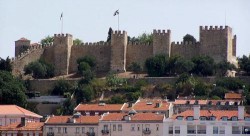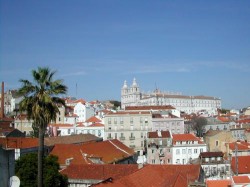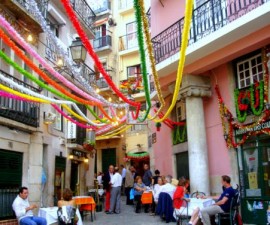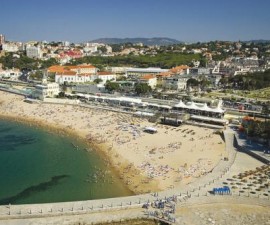Castles, churches and maritime monuments – Lisbon’s most important historical attractions fit neatly into one or other of these categories. To do the city justice, the ideal tour of Lisbon’s historical places of interest will take in one or more of each.
St George Castle sits perched on top of the highest hill in the city and is a focal point from many a direction. Constructed in the 5th century by the Visigoths, it was later transformed into a Moorish castle before becoming home to Portugal’s royal family after the Moors were expelled in 1147 by King Afonso Henriques.
St George Castle is of particular interest to English sightseers thanks to its namesake, our very own patron saint. It was dedicated to St George in commemoration of the Anglo-Portuguese pact which was made in 1371.
The route up the hill to the castle, and the grounds themselves, offer some lovely views out over Lisbon and the Tagus River beyond and this alone makes the journey worthwhile. Anyone with an interest in history however, will enjoy exploring the old castle walls and outbuildings from the main area of the royal palace.
With a strong catholic tradition, Portugal is rich with ecclesiastical treasures and Lisbon is no exception. The streets are simply bursting with historical church buildings and it is well worth taking the time to visit one or two.
Sao Vicente de Fora is a 17th-century church and monastery that boasts fine renaissance architecture and design by Italian architect, Filippo Terzi. Behind the austere walls lies a highly ornate altarpiece which was designed by Joaquim Machado de Castro, one of Portugal’s most famous sculptors.
Here in Sao Vicente de Fora also lie the remains of all the rulers of the Braganca dynasty except one, including Catherine of Braganca, the Portuguese princess who became Queen of England when she married Charles II.
Sao Roque Church was built by the Jesuits in 1574 and was one of the earliest Jesuit churches in the world. It boasts an interesting contrast between a rather plain façade and a hugely ornate interior in elegant rococo style. Sao Roque Church was one of the few buildings in Lisbon to survive the great earthquake of 1755 more or less unscathed.
Look in at the Chapel of St John the Baptist, which was designed and constructed in Rome before being completely disassembled, transported to Portugal and reconstructed in Sao Roque. It took three ships to transport the carefully crafted materials. Glistening with riches and gems, it was said at the time to be the most expensive chapel in Europe.
Another popular church to visit is the Santa Catarina Church. A fine example of baroque architecture, the Santa Catarina Church is a little further off the beaten track, in a quiet residential area of Lisbon. It makes the perfect destination for anyone with an interest in baroque and rococo design who wishes to admire it in a more relaxed and tranquil atmosphere than some of Lisbon’s other, busier churches.
Perhaps the most important of the churches is the Santa Engracia Church, which was converted during the 20th century into the National Pantheon as the burial place for a number of important Portuguese personalities. Located in the Alfama district, it is directly across the waters of the Tagus, on the opposite banks from the downtown “Baixa” district.
The National Pantheon is situated at Largo de Santa Clara in the Sao Vicente de Fora quarter of the Alfama. It is listed as a National Monument and is worth a visit not only for its historical importance but for the wonderful 360-degree panoramic views it affords from the dome at its summit out across the Tagus River to the Lisbon skyline beyond.
No tour of Lisbon’s historic attractions would be complete without considering its important maritime heritage. The Discoveries Monument was built in honour of Henry the Navigator, who led the discovery expeditions into the New World in the 15th century.
Located at Belem, the Discoveries Monument also marks the place from which Vasco da Gama embarked on his voyage from Portugal to India in 1497, and where Christopher Columbus anchored on his way back to Spain following his historic discovery of the Americas.
Here you can also admire the Belem Tower, a UNESCO World Heritage Site thanks to its historical importance with regard to the days of the discoveries.
Designed in fine Manueline style, it incorporates many stonework motifs of the discoveries and historical figures. It is possible to go inside the Belem Tower – well worth the effort for the sweeping views from the second-floor terrace.
Finish your tour with a view of the iconic Cristo Rei Statue, an iconic structure that is a replica of the Christ the Redeemer state in Rio de Janeiro and inextricably links Portugal with its new-world counterpart.






